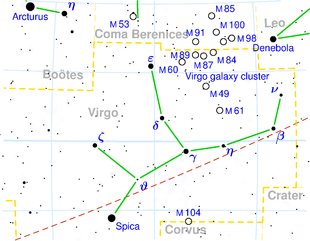Spica
|
Double star Spica (α virginis) |
|||||||||||||||||||||||||||||
|---|---|---|---|---|---|---|---|---|---|---|---|---|---|---|---|---|---|---|---|---|---|---|---|---|---|---|---|---|---|
| Spica in the constellation Virgo | |||||||||||||||||||||||||||||
|
Observation dates equinox : J2000.0 , epoch : J2000.0 |
|||||||||||||||||||||||||||||
| AladinLite | |||||||||||||||||||||||||||||
| Constellation | Virgin | ||||||||||||||||||||||||||||
| Right ascension | 13 h 25 m 11.6 s | ||||||||||||||||||||||||||||
| declination | −11 ° 09 ′ 40.8 ″ | ||||||||||||||||||||||||||||
| Astrometry | |||||||||||||||||||||||||||||
| Radial velocity | (+1.0 ± 0.9) km / s | ||||||||||||||||||||||||||||
| parallax | (12.44 ± 0.86) mas | ||||||||||||||||||||||||||||
| distance | (262 ± 18) ly ((80 ± 6) pc ) |
||||||||||||||||||||||||||||
| Individual data | |||||||||||||||||||||||||||||
| Names | A ; B. | ||||||||||||||||||||||||||||
| Observation data: | |||||||||||||||||||||||||||||
| Apparent brightness | A. | +0.92 to +0.98 mag | |||||||||||||||||||||||||||
| B. | |||||||||||||||||||||||||||||
| Typing: | |||||||||||||||||||||||||||||
| Spectral class | A. | B1 III-IV | |||||||||||||||||||||||||||
| B. | B. | ||||||||||||||||||||||||||||
| B − V color index | A. | −0.23 | |||||||||||||||||||||||||||
| U − B color index | A. | −0.93 | |||||||||||||||||||||||||||
| Physical Properties: | |||||||||||||||||||||||||||||
| Dimensions | A. | 11 M ☉ | |||||||||||||||||||||||||||
| B. | 7 M ☉ | ||||||||||||||||||||||||||||
| radius | A. | 7.8 R ☉ | |||||||||||||||||||||||||||
| B. | 4.0 R ☉ | ||||||||||||||||||||||||||||
| Luminosity | A. | 13400 L ☉ | |||||||||||||||||||||||||||
| B. | 1700 L ☉ | ||||||||||||||||||||||||||||
| Effective temperature | A. | 22400 K | |||||||||||||||||||||||||||
| B. | 18500 K | ||||||||||||||||||||||||||||
| Other names and catalog entries |
|||||||||||||||||||||||||||||
|
|||||||||||||||||||||||||||||
Spica (Latin ear of corn ), also called α Virginis , Azimech or Alaraph , is the brightest star in the constellation Virgo and the fifteenth brightest star in the night sky.
In the constellation Virgo, Spica represents the ear of corn in the hand of the virgin. In Mesopotamia , Spica was known as d šala šubultu ( god / goddess Schala, the ear of corn ), later also the Divine Maiden of the ear of corn . The Romans believed they saw the goddess Ceres in Spica. Roman names are Spicum , Spigha , Stachys (from gr. Stakhum ear of corn ) and Aristae Puella (corn girl).
The IAU has the proper name on 30 June 2016 Spica defined as standardized proper names.
Spica is a spectroscopic binary star (A / B) and an ellipsoidal variable star . Spica A is a pulsation-variable star of the Beta Cephei star type . The brightness of the Spica changes with a period of 4.0142 days between +0.92 mag and +0.98 mag. This slight fluctuation in brightness is hardly noticeable visually.
Both components of Spica are of spectral type B (B1 to B4), with the brighter star near the end of its stable time as a main sequence star . The two stars are among the hottest and therefore bluest of the bright stars in the night sky. Due to the high temperature, a large part of the light is emitted in the invisible ultraviolet range.
The brighter star has a temperature of 22,400 K and 13,500 times the solar luminosity. The radius is 7.8 times the solar radius and extends to almost 30% of the distance between the two stars. The mass of the brighter star is eleven times that of the sun. That's enough for the star to end up as a supernova .
The less well-known, less bright companion star has a surface temperature of 18,500 K , 1,700 times the solar luminosity, four times the solar radius and slightly less than seven times the solar mass.
As a star near the ecliptic, Spica can be covered by the moon and (very rarely) planets. Spica was covered by a planet for the last time on November 10, 1783 by Venus , the next occultation will be again on September 2, 2197 by Venus.
Spica is depicted in the flag of Brazil , where he represents the state of Pará .
See also
Web links
Individual evidence
- ↑ Bulletin of the IAU Working Group on Star Names, No. 1, July 2016. (PDF) Retrieved November 9, 2016 (English, 184 KiB).

